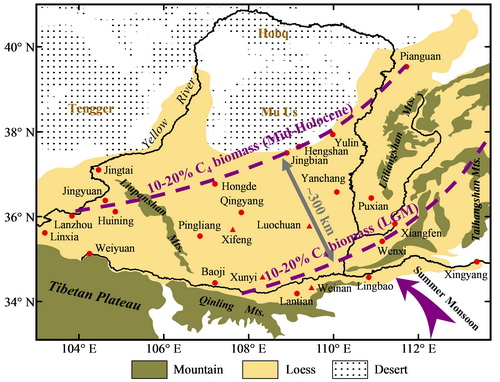
The East Asian monsoon has been decreasing since the 1970s. As a result, the monsoon rain belt has migrated southward, with more droughts in northern China countered by more floods in southern China. The trend of decreasing monsoon intensity has been attributed to global warming by many scientists, thus raising great concerns over further drying in northern China as global warming continues. It is crucial to identify whether the recent drying is transient or whether it signals the start of a long-term drying trend induced by global warming.
Glacial–interglacial changes in the distribution of C3/C4 vegetation on the Chinese Loess Plateau are related to East Asian summer monsoon intensity and position and could provide insights into future changes caused by global warming.
For the past several years, ZHANG Shiling, DING Zhongli and colleagues from the Institute of Geology and Geophysics of the Chinese Academy of Sciences (IGGCAS) have investigated over 20 loess-soil sections.
By measuring 14C ages and the carbon isotope composition (d13C) of organic matter in soil, they have reconstructed the spatiotemporal pattern of C4 vegetation on the Chinese Loess Plateau for the past 20 ka. The results show that C4 vegetation increased gradually both from the LGM to the mid-Holocene in each section and from the northwest to the southeast in each time interval (Fig. 1), indicating that C4 biomass is closely related to summer monsoon precipitation.
Further analysis shows that the isolines of C4 biomass exhibit a northeast–southwest zonal distribution pattern, closely resembling the pattern of present monsoon precipitation (Fig. 1). Thus, the migration of C4 isolines effectively indicates a change in the position of the monsoon rain belt.
The 10–20% isolines for C4 biomass in the southeastern part of the Loess Plateau during the LGM moved to the northwestern part during the mid-Holocene, indicating a northwesterly monsoon rain belt advance of ∼300 km for the warm Holocene compared with the cold LGM (Fig. 2).
These results show that global warming will shift the East Asian monsoon rain belt to the northwest. It follows that the southward displacement of the monsoon rain belt and the drying trend observed during the last few decades in northern China will reverse as global warming continues.
The findings provide a scientific basis for the evaluation of the effect of global warming on climate and on ecologically vulnerable areas in northern China.
This study was recently published in PNAS (Yang et al., Warming-induced northwestward migration of the East Asian monsoon rain belt from the Last Glacial Maximum to the mid-Holocene, PNAS, 2015).

Fig. 1. Contour maps of estimated C4 biomass (%) for the Last Glacial Maximum (LGM) and the mid-Holocene, together with modern mean warm-season precipitation (May to September) over 51 y (1951–2001). Note the migration of the 10–20% isolines for C4 biomass (pink lines) between the LGM and the mid-Holocene. (Image by YANG Shiling et. al)

Fig. 2. Migration of the East Asian summer monsoon rain belt (purple dashed lines) between the Last Glacial Maximum (LGM) and the mid-Holocene as reconstructed using the 10–20% isolines for C4 biomass shown in Fig. 1. The monsoon rain belt migrated at least 300 km to the northwest from the cold Last Glacial Maximum (∼19 ka) to the warm Holocene (∼4 ka). (Image by YANG Shiling et. al)
Contact:
YANG Shiling
Division of Cenozoic Geology and Environment, IGGCAS
E-mail: yangsl@mail.iggcas.ac.cn

86-10-68597521 (day)
86-10-68597289 (night)

86-10-68511095 (day)
86-10-68512458 (night)

cas_en@cas.cn

52 Sanlihe Rd., Xicheng District,
Beijing, China (100864)

